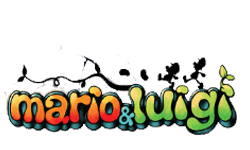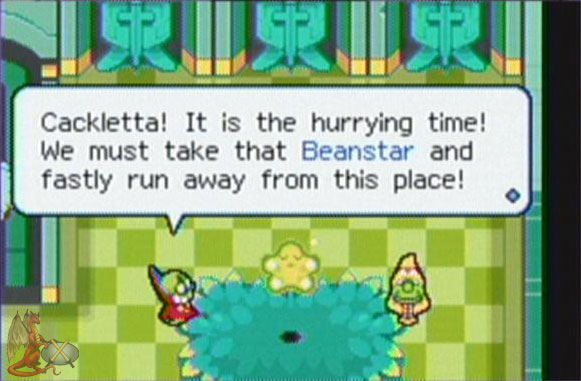|
|

|
BATTLE SYSTEM
|

|
INTERACTION
|

|
ORIGINALITY
|

|
STORY
|

|
MUSIC & SOUND
|

|
VISUALS
|

|
CHALLENGE
|
Insubstantial
|
COMPLETION TIME
|
20-25 hours
|
|
OVERALL
4.0/5
|
Rating definitions
|
|
|
The Game Boy Advance has been granted quite a few quality RPGs. Tactical, action, card-battling, monster-collecting, and relatively straightforward, GBA has not lacked. But where is the prospective player to come by a GBA RPG that offers an amusing take on the RPG norms instead of a serious? The options are quite limited, with the premium possibility probably placed in the form of Mario & Luigi: Superstar Saga.
Mario and Luigi, amazingly enough, take center stage in this entry in the ever-growing field of Mario RPGs. The story, stated baldly, is nothing innovative in the slightest; Princess Peach has her voice taken away by the evil Cackletta, with the purpose of using it to unlock the power of the Beanstar. Mario and the dragooned Luigi must defeat Cackletta and protect the Bean Kingdom, faithful ally to the Mushroom Kingdom. This story does not outwardly seem anything too engrossing. To better illustrate exactly why a capsule summation does an injustice here, however, I shall borrow from Roger Ebert (whose dislike of video games will be glossed over): It is not what a game is about, but how it is about it. And how Mario & Luigi is about its story is; complete wackiness. This framework of a plot is abetted with goofiness at every turn and never becomes boring: an example would be early on when Luigi is mistaken (due to his green attire) for a laggard Koopa trooper and forcibly brought onto Bowser’s airship. This is far more amusing to see than to hear, believe me.
 Masochists again, eh?
Masochists again, eh?
|
|
Combat is frequently repetitive in the classic-style RPG. Mario & Luigi refuses to be bound by blandly boring battles, and even encounters with weaker enemies prompt enthusiastic activity on the part of the player. Mario & Luigi are a true team in combat – if one is knocked out the other attempts to keep the first from injury by assuming his position. With every enemy attack Mario and/or Luigi have the opportunity to dodge or counterattack. All it takes is classic Mario-style timing. An enemy will pop up in front of one of the brothers; with proper timing a hammer can be used at the appropriate moment to bash the interferer back down into the dirt instead of taking a hit. Mario is commanded via one button and Luigi via the other. Each will automatically take the appropriate action for the attack being used against them. When one of their turns comes up, the player can choose between basic attacking (which will expand in expression and effectiveness as the game goes on), item use, running, or a Brothers attack. Brothers attacks are the equivalent of magic in Mario & Luigi, with both brothers needing the required MP to make it happen. These also depend upon timing of the player, as do regular attacks. Proper timing adds extra damage and can allow for more powerful renditions of Brothers abilities eventually.
As is necessary for such a battle system, the interface is top-notch. Outside of battle is particularly worthy of mention, since challenges in the field and puzzles require different application of Brothers abilities that will be taught and then left to the player for further deciphering. Switching between the ability currently at hand for Mario and Luigi, along with which brother is currently in front (this affects what ability can be used) is just a button press away. Translation is quite good as well.
Visuals are nothing exceptional but convey the Mario aesthetic quite well. They generally look like an upper-tier Super Nintendo title, which fits the GBA’s potential without straining it. Music is quite catchy, as befits Yoko Shimomura’s compositions. The GBA’s innate sound quality is a culprit here though, as without headphones listening to the music becomes an exercise in frustration thanks to the tinny built-in speaker. Voice is limited to quick little sound bites, sound effects are effective without impressing one via their incredible nature.
 How dare I not mention Fawful-the-memorable in the proper review!
How dare I not mention Fawful-the-memorable in the proper review!
|
|
Mario & Luigi is not what seekers of an intense challenge should make a beeline towards. Aside from invented challenges (can a player actually get through the game without taking a hit? It is possible!), the main quest does not become very difficult. There are some exceptions, and the final battle is a significant step up from most battles previously fought, but even so a great challenge is not to be found here. The main quest has no side quests whatsoever, also. There are plenty of minigames and time-suckers to be found for the interested player, but replay in search of additional content will not be necessary.
If one is interested in a story-intensive, almost entirely serious game, Mario & Luigi will disappoint. It does not last very long and its core story is not terribly interesting (wouldn’t you know it, Peach gets kidnapped again! Sorry if I spoiled that for someone.) For a fast, frivolous, funny, and fun title on the other hand, this will definitely work out wonderfully. Just when things start to get a little repetitive near the end, it’s over.
Review Archives
|









